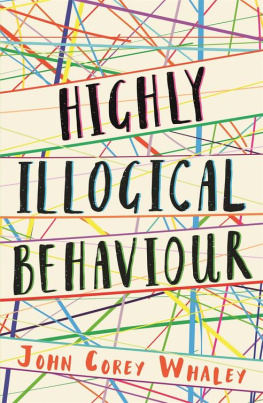DRIVER BEHAVIOUR AND TRAINING
Human Factors in Road and Rail Transport
Series editors
Dr Lisa Dorn
Director of the Driving Research Group, Department of Human Factors, Cranfield University
Dr Gerald Matthews
Professor of Psychology at the University of Cincinnati
Dr Ian Glendon
Associate Professor of Psychology at Griffith University, Queensland, and President of the Division of Traffic and Transportation Psychology of the International Association of Applied Psychology
Todays society must confront major land transport problems. The human and financial costs of vehicle accidents are increasing, with road traffic accidents predicted to become the third largest cause of death and injury across the world by 2020. Several social trends pose threats to safety, including increasing car ownership and traffic congestion, the increased complexity of the human-vehicle interface, the ageing of populations in the developed world, and a possible influx of young vehicle operators in the developing world.
Ashgates Human Factors in Road and Rail Transport series aims to make a timely contribution to these issues by focusing on the driver as a contributing causal agent in road and rail accidents. The series seeks to reflect the increasing demand for safe, efficient and economical land-based transport by reporting on the state-of-the-art science that may be applied to reduce vehicle collisions, improve the usability of vehicles and enhance the operators wellbeing and satisfaction. It will do so by disseminating new theoretical and empirical research from specialists in the behavioural and allied disciplines, including traffic psychology, human factors and ergonomics.
The series captures topics such as driver behaviour, driver training, in-vehicle technology, driver health and driver assessment. Specially commissioned works from internationally recognised experts in the field will provide authoritative accounts of the leading approaches to this significant real-world problem.
First published 2013 by Ashgate Publishing
Published 2016 by Routledge
2 Park Square, Milton Park, Abingdon, Oxon OX14 4RN
711 Third Avenue, New York, NY 10017, USA
Routledge is an imprint of the Taylor & Francis Group, an informa business
Copyright Lisa Dorn, Mark Sullman and the contributors 2013
Lisa Dorn and Mark Sullman have asserted their right under the Copyright, Designs and Patents Act, 1988, to be identified as the editors of this work.
All rights reserved. No part of this book may be reprinted or reproduced or utilised in any form or by any electronic, mechanical, or other means, now known or hereafter invented, including photocopying and recording, or in any information storage or retrieval system, without permission in writing from the publishers.
Notice:
Product or corporate names may be trademarks or registered trademarks, and are used only for identification and explanation without intent to infringe.
British Library Cataloguing in Publication Data
A catalogue record for this book is available from the British Library
The Library of Congress Control Number: 2003058287
ISBN 9781472414694 (hbk)
Change in the structure of action during training
Driving simulator
Predictors of subjective workload
Effects of driving experience on subjective workload
Predictors of the number of collisions
Effects of subjective workload on the number of collisions
Effects of subjective workload on the number of collisions depending on situation complexity
The TRL DigiCar and instructor station
Mean ratings and standard deviations for ratings of task difficulty, feeling of risk and likelihood of a crash on urban roads and on the dual carriageway
Estimated marginal means plots for the significant interaction between speed and age on urban roads
Estimated marginal means plots for the significant interaction between risk and age on urban roads
Estimated marginal means plots for the main effect of age on urban roads
Estimated marginal means plots for the main effect of age on the dual carriageway
Model of competent task performance
Cut-off scores and standard errors for 13 versions of the Theory of Driving Test
Cut-off scores and standard errors for 15 versions of the Theory of Lesson Preparation Test
Cut-off scores and standard errors for 15 versions of the Theory of Instruction and Coaching Test
Results of the pilot study
Mean risk scores of situations
Average DPQ-scores
Ratings and skin conductance measures during dangerous and safer sections of hazard videos divided by whether the participant had previously been frustrated by attempting to solve impossible anagrams or not (control condition)
Physiological and eye movement measures during dangerous and safer sections of hazard videos divided by whether the participant had previously been frustrated by attempting to solve impossible anagrams or not (control condition)
Self-reported anger across baseline, maintenance and implementation phases
Anger inducing scenes A: traffic jam B: slow moving car C: tailgater
Experimental order of events
Mean rated intensity of anger, type of music and music presentation
Amount of anger reduction in relation to the experimental conditions
Shape of the crossing and angle of the video camera
A single frame from a video
Evaluations from the others point of view and from ones own point of view
Scatter plot of the evaluations from the others point of view and from ones own point of view
Model of behaviour and self-evaluation
Distribution of the full stop rate before and after drivers were informed
Flow chart of the discussion process
Components of visual overtaking distance
Typical record of overtaking episode
Distribution of time and distance used for overtaking manoeuvre
Distribution of overtaking distance (S1+S3)
Distribution of overtaking speed (V1)
Samples of GSR artefacts
Mobile subscriptions, world and development level (ITU, 2011: 2)
Mobile phone ownership in Northern Ireland (CSU, 2011: 4)
Lane position for both visual and auditory cognitive tasks (Jamson and Merat, 2005: 91)
Task-Capability Interface model (Fuller, 2005: 465)
Levels of awareness and activity control loops (Bellet et al., 2009: 1208)
Tracking errors/time on task (Van Orden, Jung and Makeig, 2000: 226)
Process involved in applying parking brake to hold the vehicle stationary
Cause and effect diagram for vehicle failing to remain stationary
Fault tree analysis for parked unattended vehicle failing to remain stationary
Parking practice reported by respondents
Reasons provided for parking practice











